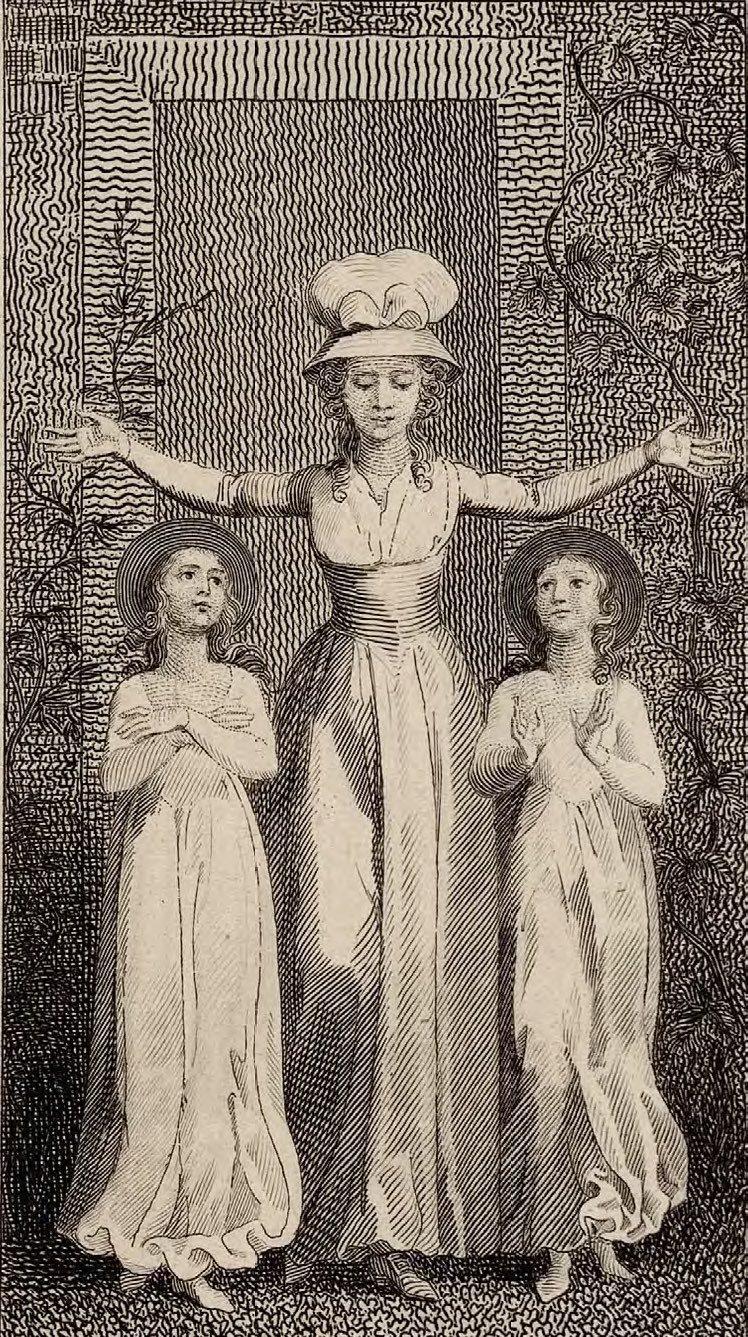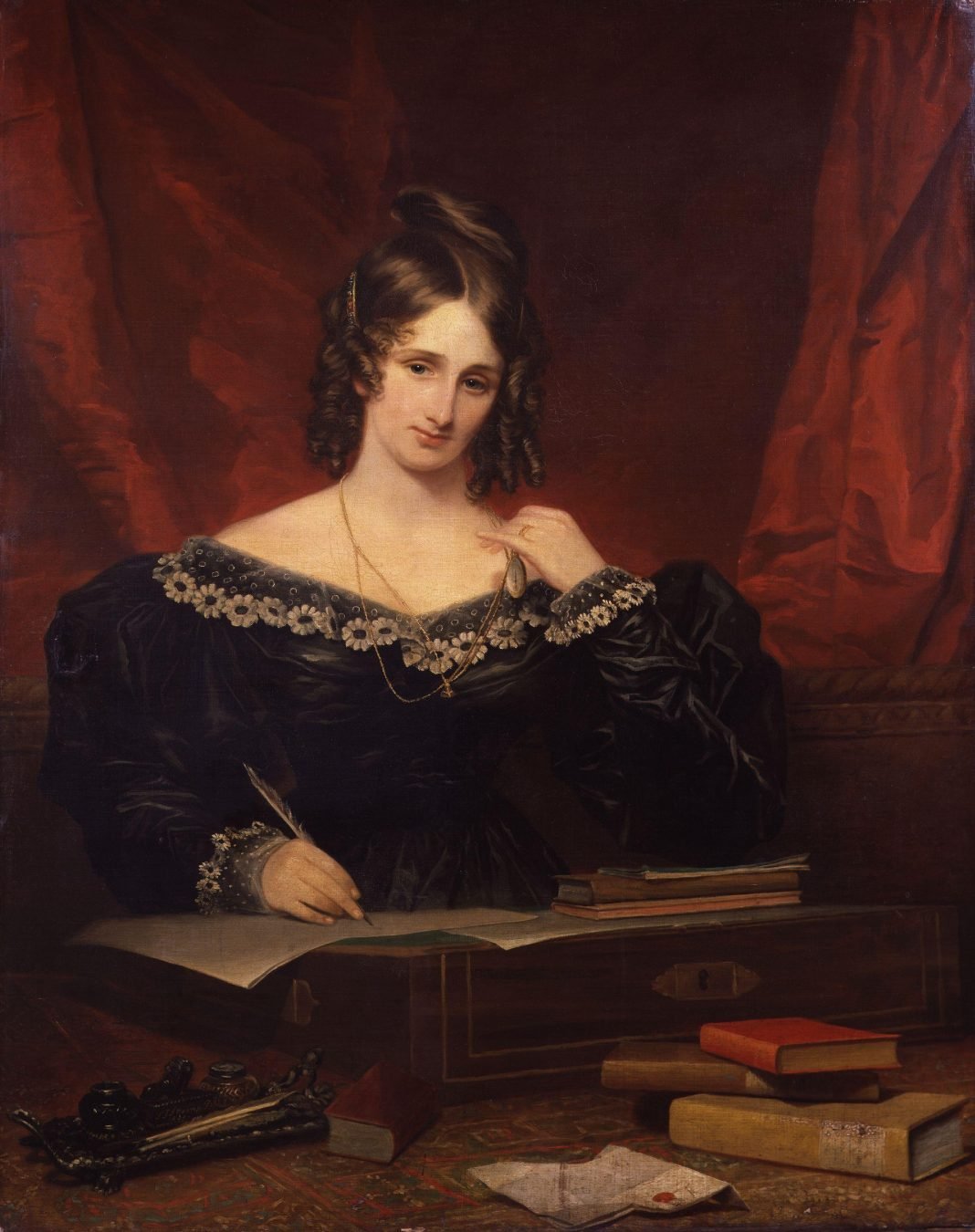Feature image: Portait of Mary Wollstonecraft Shelley, 1831, by Samuel John Stump
“I perceived in the gloom a figure which stole from behind a clump of trees near me; I stood fixed, gazing intently: I could not be mistaken. A flash of lightning illuminated the object, and discovered its shape plainly to me; its gigantic stature, and the deformity of its aspect more hideous than belongs to humanity, instantly informed me that it was the wretch, the filthy dæmon, to whom I had given life. What did he there? Could he be (I shuddered at the conception) the murderer of my brother? No sooner did that idea cross my imagination, than I became convinced of its truth; my teeth chattered, and I was forced to lean against a tree for support. The figure passed me quickly, and I lost it in the gloom.”
—From Frankenstein
by Mary Shelley
When Lord Byron came to visit Mary and Percy Shelley for an extended stay in Pisa, the English press hordes followed. They came to dig up dirt on the eccentricities and escapades of Byron, who was an infamous rake—and the rock star of his time. In the spirit of modern-day tabloids like the Star or the National Enquirer, the salacious early 19th century press referred to the trio as “the League of Incest and Atheism.”
One has to admit, it’s a pretty good name for the boys (and girl!) in that particular band. Never mind that it wasn’t quite true, though partly it was. Everything the Romantics did was fodder for the tabloids. English society was scandalized by their behavior—children born out of wedlock, free love, a belief in an “outspoken and honest exchange of ideas” between the sexes, according to Mary, which was shocking in 1821. Although the gossips of the day judged the writers harshly (especially Mary, because she was a woman), they found the group’s alleged antics ever titillating, and in the true spirit of hypocrisy, they hung on every detail. And if it wasn’t all true, well, when did that ever stop anyone?
Byron may have been the rock star, but it was Mary who suffered throughout her life as the target of sexist attacks that vilified her for not standing down to men. They struck at the heart of what was most humiliating in those days, and speculation ran wild: Was Mary sleeping with Byron and Percy Shelley? Was Claire Clairmont, Mary’s stepsister, who lived with the Shelleys on and off through the years, the third wheel in a ménage à trois? Whose babies did Mary give birth to, really? Were they Percy Shelley’s—or Byron’s? (They were Shelley’s.) Claire had a baby girl with Byron, and the gossips murmured that she was Percy Shelley’s baby too.

Mary Shelley was seventeen years old wh en she ran off with twenty-one-year-old Percy Bysshe Shelley, a friend of her father’s whom she met over dinner in her family home. Once word got out, Mary was snubbed by friends and society. Living with a married man (Percy was still married to his first wife, Harriet, with whom he had two children), disowned by her father (they reconciled later on), cast out by society, and pregnant, she certainly had a lot on her plate. But she and Shelley were deeply in love. They were intellectual equals. They did not believe in marriage—“I attach little value to the monopoly of excessive cohabitation,” said Shelley—though they did marry later on, after Harriet died, when Mary was once again pregnant. Most of all, they believed in freedom and the free and open exchange of ideas. “Our house is very political as well as poetical,” Mary told a friend.
When she wrote Frankenstein, Mary was only nineteen, still a teenager when she created one of the most famous stories and iconic characters of all time. Granted, women grew up fast in those days—they had to get an early start, as they couldn’t count on living too long. Mary didn’t waste any time and used her writing to shed light on political and social injustice, as she did allegorically in her first novel. It’s just that in those days, it was scandalous for a woman to do it, and it took tremendous courage. And Mary paid the price. She was called a whore, a virago, a “wanton,” all of which caused her great personal pain. Fortunately, she was made of strong stuff.
In fact, Mary Shelley was born to be a feminist. Her mother, Mary Wollstonecraft, wrote A Vindication of the Rights of Women in 1791, a groundbreaking work that even now, hundreds of years later, is required reading in most women’s studies courses. Most shocking, in Vindication, Wollstonecraft wrote that unshackling women—creatively, emotionally, economically, artistically—was not only important for women but crucially important for the well-being of men too.
Wollstonecraft died ten days after Mary was born, but she was still probably the biggest influence in her daughter’s life. “The memory of my mother has always been the pride and light of my life,” Mary said. She and Percy reread Wollstonecraft’s works to each other and strove to live by her ideals. Mary’s father, no intellectual slouch himself, was William Godwin, author of An Enquiry Concerning Political Justice. His ideas about equality of the sexes were also considered radical at the time. Godwin proudly called his daughter “spirited” and described her as “singularly bold, somewhat imperious and active of mind. Her desire of knowledge is great, and her perseverance in everything she undertakes, almost invincible.”
Mary was extremely well-educated for a woman of her time. She taught herself several languages, and her intellectual curiosity led to a life of research, study, and writing that she refused to give up, even though she didn’t always get credit for it. Case in point: Frankenstein, her most famous work, was assumed to have been written by a man. Most assumed that Percy wrote it. He did write the preface, after all. When the truth came out that a woman wrote Frankenstein, Mary received a lot of hate. Women were supposed to be gentle, docile, pliant. How could such a gripping tale of horror come from the delicate sensibility of a woman?

As the story goes, one stormy night, Lord Byron, the Shelleys, John Polidori (Byron’s doctor friend), and Claire were hunkered down in Byron’s rented castle, Villa Diodati, overlooking
Lake Geneva. Trapped indoors, they passed the time reading ghost stories, talking about science and the supernatural, and attempting to amuse themselves while they were stuck inside. Byron proclaimed, “We will each write a ghost story.” They each set to work, but Mary was stuck. According to her letters, every day her companions asked, “Have you thought of a story?” “Each morning,” Mary wrote, “I was forced to reply with a mortifying negative.”
One night she went to bed and a series of images flowed into her head. “I saw, with shut eyes, but acute mental vision, the pale student of unhallowed arts kneeling beside the thing he had put together,” Mary wrote. The next morning she announced to the group that she had, indeed, thought of a story. In 1818, Frankenstein became a best seller, and Mary updated it in 1831.
That night turned out to be a bonanza for supernatural storytelling: Polidori also rose to the challenge with his The Vampyr: A Tale, which is said to have inspired Bram Stoker’s Dracula.
Mary and Percy only had eight short years together. He died in a boating accident in 1822, leaving her a widow with a young son at age twenty-five. But in that brief time, they shared a loving relationship firmly built on equality. Mary did not live in Percy’s shadow, not for one minute. In fact, she was more famous—and infamous—than he was. She edited his work and he edited hers. (After his death, her compilation of his poems made him famous.) Mary and Percy were in love, true partners in life and art. In the dedication of his moving poem, “The Revolt of Islam,” Percy wrote to Mary: “How beautiful and calm and free thou wert, / In thy young wisdom, when the mortal chain, / Of custom thou didst burst and rend in twain.” In its first canto he writes, “A star among the stars of mortal night, / If it indeed may cleave its natal gloom, / Its doubtful promise thus I would unite, / With thy beloved name, thou Child of love and light.” After Percy died, Mary lived with her son and eventually her son’s wife, until she died of a brain tumor at age fifty-three. Though she had “attachments,” as they were known in those days, she spent the rest of her life alone.
It was hard enough just to be a woman in the early 19th century. Employment prospects were limited to governess, servant, or prostitute, and even in the upper classes, it was difficult to get an education. Women needed their husband’s permission for most things, and by law they and their children were considered their husband’s property. They had no rights to property of their own. Women were supposed to stay home and take care of their children. Infant mortality was high, which meant that most women could count on suffering the loss of children in infancy or early childhood. Mary lost three children, and only her son Percy survived into adulthood.
Mary was an early adopter of questions that still drive women crazy today. Why shouldn’t women be treated equally to men? Why shouldn’t they enjoy the same rights and freedoms without being ostracized, criticized, and stigmatized for it? Of course, the men in Mary’s day had the same reasons for holding women back as they do today, except they couched it somewhat differently. Instead of being honest about wanting to have the upper hand and have the balance of power ever tilt in their direction, men in the early 19th century flipped the argument to make it about women’s weakness and women’s need for a protector.
Just imagine the courage it took for Mary to stand up for women’s rights, for the freedom to be herself, to love whom she wanted on her own terms, to create the work that lived inside her, and to risk everything for the right to be free and equal to men. Women are still struggling today, hundreds of years later.
No doubt, Mary suffered greatly and she was judged harshly. But her work is her testament, and it is as fresh, modern, and forward-thinking now as it was 200 years ago. She wrote essays, translations, and five novels, from Frankenstein to The Last Man, a prescient postapocalyptic novel set in the 21st century after humankind destroys itself. Mary was truly exceptional, but she had to fight tirelessly to live the life she wanted to live. A rebel, a fighter, a charmer, an activist, an artist, and a genius, Mary Shelley was a woman who made it a lot easier for all women who followed.
NOTE: To learn more about The Romantics—Percy Bysshe Shelley, John Keats, Lord Byron, Samuel Taylor Coleridge, William Blake, William Wordsworth—read their work. Their lives have also inspired modern romantic films like Bright Star, Rowing With the Wind, Mary Shelley, Haunted Summer, and Gothic.


































